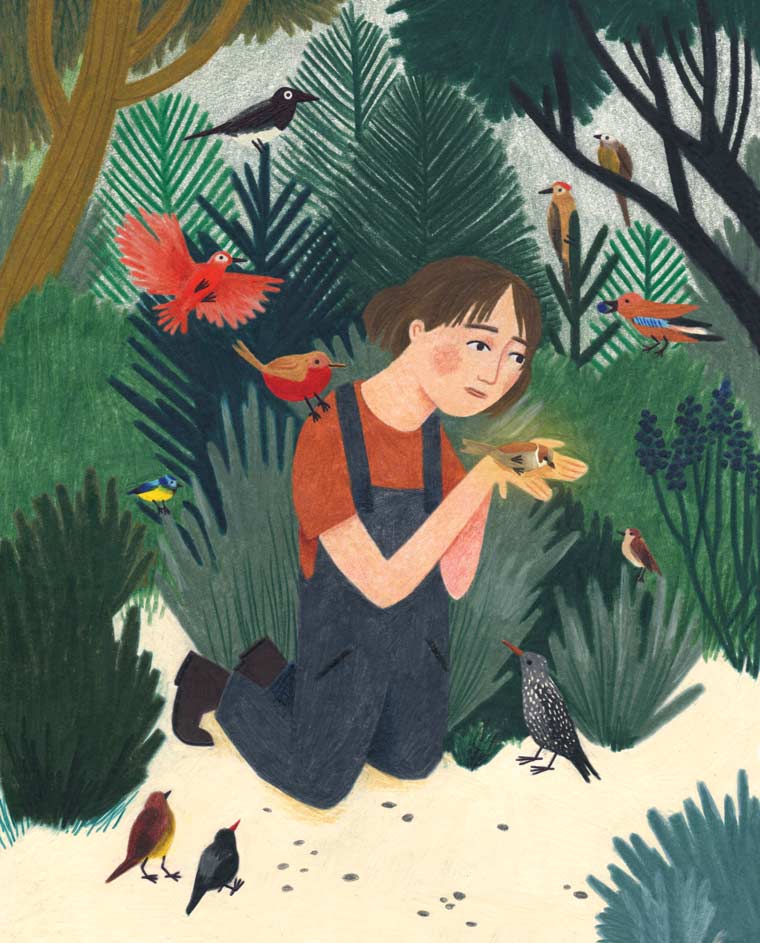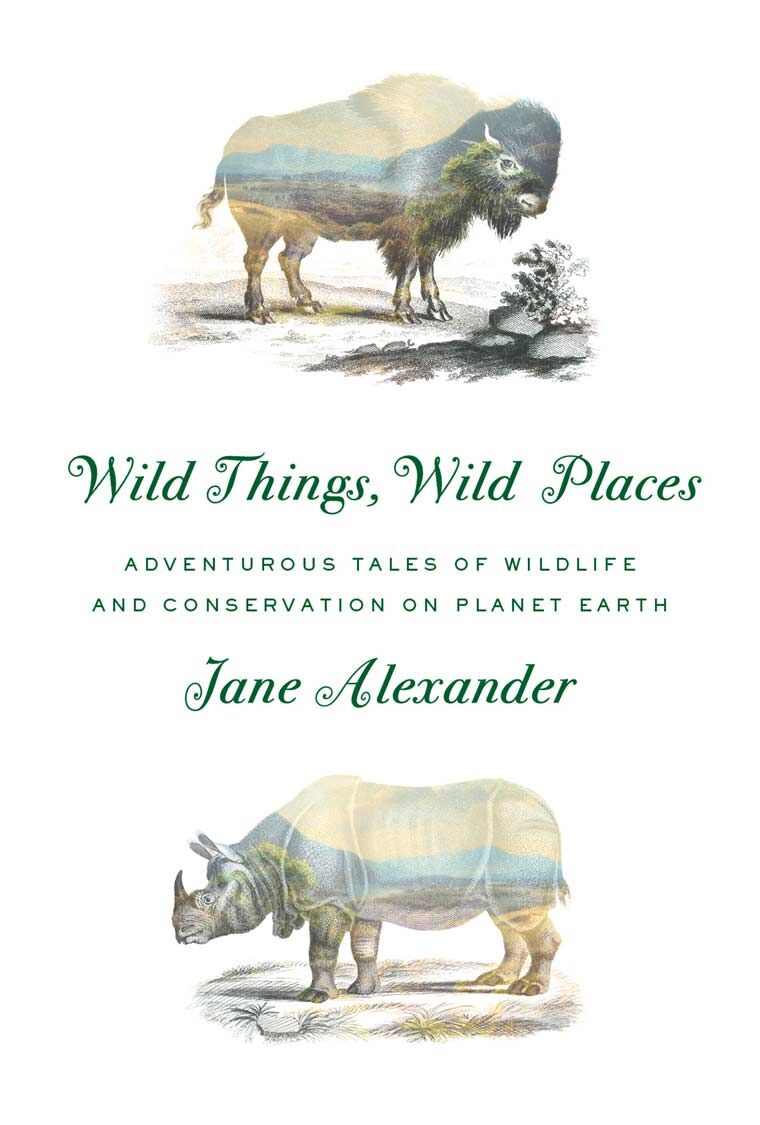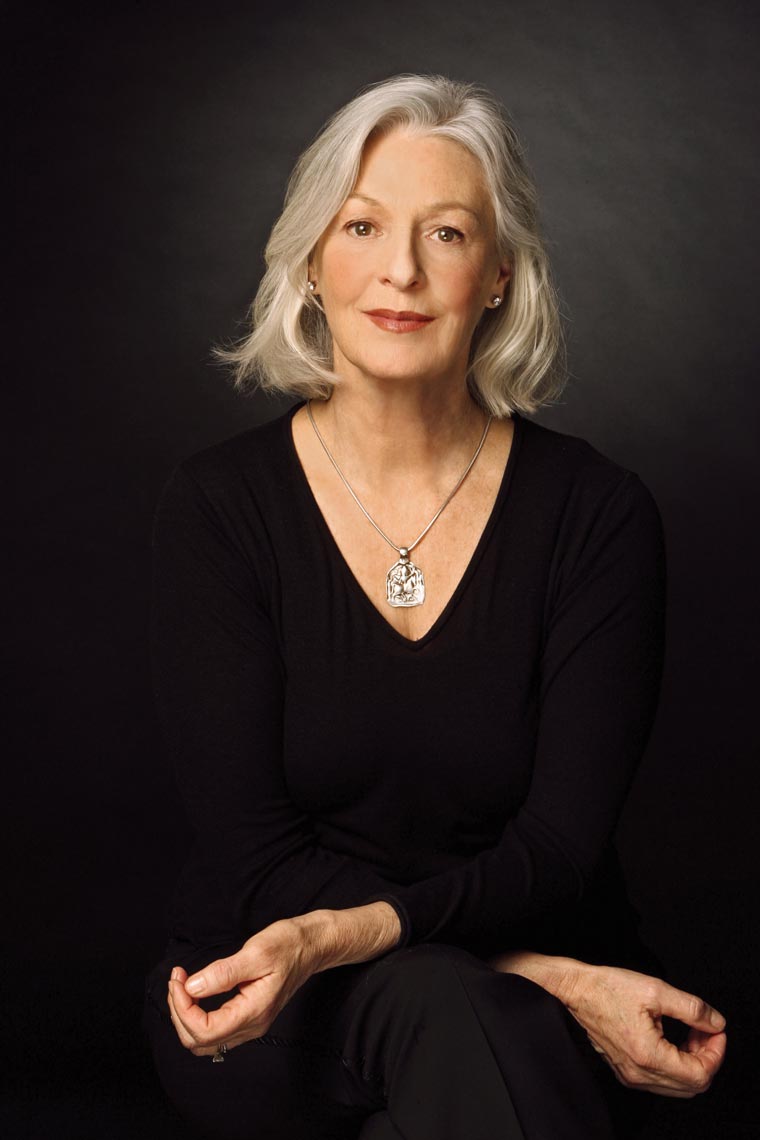Before traveling the globe with the scientists and conservationists who fight to save at-risk animals, a wildlife ambassador first falls in love with the birds in her own back yard.

We lived on Pill Hill, where almost all fathers were doctors. Hawthorn Road was a short street with just 11 houses. My dad finally came home from the war after four and a half long years with the Fifth Army Hospital in England, and he and my mother bought the old clapboard house in Brookline, Massachusetts, for $10,000. Those postwar years were special. The country was in a celebratory mood, and for families reuniting there was joy in the air. We kids spilled out of our homes to play Kick the Can before supper or to race down Cumberland Avenue to look for turtles or minnows in the Muddy River shallows.
There was a vacant lot we called “the woods” catty-corner from us where I climbed trees, examined bugs, and first became interested in the natural world. The intense fear I had of spiders dissipated when my mother took a huge spider from under the back porch eaves and let it crawl up her arm and over her head. She didn’t flinch. I thought she was the bravest person in the world. In our little plot bordering Boston, she taught me what she had learned of nature as a girl in Nova Scotia, and she began to name the birds. There were starlings squeaking noisily in the locust tree, a Mockingbird perched on the streetlamp, and a Robin who woke me each morning with his sweet song.
At the end of the street was a clay tennis court where our neighborhood gang hit the ball around when the weather was good. There was always a flock of House Sparrows there, snug against the chicken wire eating something. At 10 years old I became intensely curious about flight. I jumped off rocks and bluffs trying to fly and made balsa-wood wings to aid in the effort. My favorite story was the myth of Icarus, who flew on wings of feather and wax too near the sun and plummeted to the ground. I loved the illustration of him in the book of Greek myths Dad read to us before bed. Icarus was like a great eagle soaring toward the sun, his wing tips bowed against the air. It was the ultimate picture of freedom. I guess my brother Tom loved it too, because in his 20s he joined the Marines, served in Vietnam, and became a pilot for life.
The little sparrows gave me an idea. I took my clunky balloon-tire bike up the embankment on the far side of the tennis court and then pedaled like mad across the court in ambush. It worked! One sparrow couldn’t get up in time and was caught in the chicken wire. I held the creature in the palm of my hand and felt its trembling heart. The bird was so light. I looked into its eyes, its beak yammering in protest, then turned it over on its back and extended one wing, examining the structure. I turned it over again, opened my palm, and watched as it magically lifted into the sky. Perfection.
Puberty hit with a vengeance. Icarus was replaced by the goddess Aphrodite, and sparrows by boys. I discovered acting.
The woods were replaced by theatre and an equally enchanting world of make-believe. I did not get back to birds for 20 years.
My career was well established when my husband Ed Sherin and I bought our house in Putnam County, just 60 miles north of New York City, a place where our four boys from our first marriages could play and grow. A gracious lawn rolled down a slope past a lily pond over a brook to a pasture and an old orchard of 20 trees. Behind us was a forest bordering on state conservation land. Wildlife was everywhere.
A herd of White-Tailed Deer wandered the orchard eating drop apples. Occasionally a River Otter slipped into the brook’s pool, created by the dam of an old sawmill. He splashed for Brook Trout and Water Snakes. Opossums cornered by our curious dog played dead in the woodpile. Rabbits made smooth bowls in the earth beneath cat briar and birthed a dozen bunnies. Wood Turtles with bright orange legs bred in the wetlands, and baby turtles could be found nibbling on pasture flowers in May.
One spring day a family of Barn Swallows came wheeling up the lawn from the south, circling excitedly round and round like kids tumbling out of a station wagon at their summer home. They nestled under the back deck and busily built mud cups for eggs, as they had for all the years the previous owners occupied the house.
A pair of Eastern Phoebes, sweet black-topped flycatchers, arrived on March 25, as they did every year afterward, give or take a day or two. They staked out a little shelf under the roof overhang and built a nest of moss and grass and mud. Their soft fee-bee call was comforting. They darted out from a branch above the stream or the pool and grabbed little white moths or flies for their chicks. It took hundreds to fill the four gaping mouths every day.
We shared our place with hundreds of species—or thousands, if you included insects. And all these creatures predated us in lineage of the land—maybe for millennia. We were the interlopers, but we would be careful not to interrupt the conditions that allowed them to thrive.
They became friends and, perhaps sensing my joy in them, moved closer: the House Wren, the Robin, the Phoebe, and Barn Swallows practically lived in the house with us, and in time the little Brown Bats did live in the house with us, under the roof, while the slender Ring-Necked Snakes birthed their young in the foundation.
The birds continued to enthrall me the most as the seasons went by in our country home. The Great Blue Heron, sensing sanctuary, barely budged when we ran down to the lily pond hoping to keep just one Goldfish alive after the rest had been devoured. We saw the looping display of the Woodcock courting in the orchard and the Louisiana Waterthrush, which is not a thrush at all but a warbler, teetering at the edge of the brook, its sweet song burbling against the water’s lap. The fuchsia-red blaze against the white of the Rose-Breasted Grosbeak looked like a crucifix on an Easter chasuble.
While I came to know the birds at my feeder best, there was one stationed 50 feet into the woods that kept his distance. This was a bird whose song transported me. I waited for it in the morning before I rose and in the evening at dusk. It is the bird I love the most, and the song gives me chills. It seems of another realm. We were lucky to have a Wood Thrush call our place home. In the 34 years we lived there we had several generations of Wood Thrush songsters, and I can say emphatically that there are singers and then there are singers.
This was a bird whose song transported me. I waited for it in the morning before I rose and in the evening at dusk.
At some point the one I called “the grand old man” began to sing. He was with us for five years. His song was to the previous Wood Thrush as Pavarotti’s is to Garth Brooks’: both are good singers, but the former takes your breath away. I spent enough time listening to the grand old man to begin to believe that he knew he was remarkable. I had the feeling that perhaps the whole forest stopped to listen. He began to improvise, and the song became more than the standard e-olay. It became intricate in its dynamic, one phrase drawn out and full-throated and the next rippling down softly as if spilling from a bowl. He had a deep alto resonance. He was raising the bar in the Wood Thrush world.
One evening an astonishing event occurred. It was one of those perfect late July evenings, golden light and about 75 degrees. We were sitting on the back deck when the grand old man tuned up. He sang gloriously for about five minutes and then suddenly was joined by not one but two others who must have been sitting about 10 or 20 feet on either side of him. He would begin and then the second one would come in softly and then the third, almost as if singing a round, but then they deviated. They would truncate phrases, pull a note out of a high register, take off from one another, undercut with a low note, one doing a percussive rat-a-tat chip-chip as counterpoint, and then they would end with a flourish before starting again. This went on for about 20 minutes—a Wood Thrush jam session. Jazz in birdland—worthy of Charlie Parker or Miles Davis. Were the other two learning from the master? Were they juveniles learning from dad? If so, they were learning without any prior lessons that I had heard. I never knew the answer, but in the two weeks that followed we were treated to three more concerts.
The grand old man was my “spark bird,” the one who turned my love for birds into a passion. I never look or listen to a bird today without seeing or hearing its individuality—especially if I am lucky enough to live with them nearby.
Here is a bit of a poem by the 19th century’s Gerard Manley Hopkins, on the English Song Thrush:
Nothing is so beautiful as Spring—
When weeds, in wheels, shoot long and lovely and lush;
Thrush’s eggs look little low heavens, and thrush
Through the echoing timber does so rinse and wring
The ear, it strikes the lightnings to hear him sing …
What is all this juice and all this joy?
Indeed! What is this juice and joy? Hearing the grand old man sing was to believe he did it for the joy of it, especially in August after the breeding season. The English Thrush cannot compare with our Wood Thrush of the Western Hemisphere, but thrushes the world over pour out their joyous morning songs to the delight of human beings everywhere.
The Audubon Society has more than 460 chapters all over the United States. I joined the Putnam Highlands chapter hungry to learn about birds by going out with folks who knew them. An older man named Tom Morgan took me along on May mornings to spot warblers migrating north. Tom was bent over from osteoporosis, making it hard for him to look up, so he knew the songs of all the birds—hundreds of them. It was a wonder to me how he distinguished between a Magnolia Warbler, a Yellow Warbler, or a Redstart. We would sit on a granite outcropping in the hilly terrain of Fahnestock State Park, and Tom would tell me about the birds: “Hear that? A Canada Warbler. And there’s a Fox Sparrow, and a Scarlet Tanager.” I was hopeless at the art for many years.
When you fall hard for something, really fall in love, as I did with birds, the desire to protect it comes naturally.
When you fall hard for something, really fall in love, as I did with birds, the desire to protect it comes naturally. My involvement with the Wildlife Conservation Society began in the mid-1980s when Alan Rabinowitz introduced me to William Conway, its director, believing that my passion for animals translated well to conservation work. Dr. Conway agreed, appointing me readily to the Conservation Committee.
The Wildlife Conservation Society was the spiritual home I had always dreamed of, giving larger meaning to my life. A thousand scientists in the field in more than 50 countries researched animals, finding ways to save them. I spent countless hours in WCS zoos in Queens, Brooklyn, and Central Park, and in the Coney Island aquarium, becoming acquainted with the men and women who work behind the scenes as keepers and geneticists. I began to know the animals and was especially drawn to the new Bird House, which Conway helped create. I began to travel, first as a member of the Conservation Committee and later as a trustee, visiting biologists around the globe. I became friends with scientists whose stories surpassed the wildest scenarios of film and theatre. My focus was shifting from the imaginary world to the wild and precious real one.
My decision to capitalize the names of all animal species breaks with tradition, though the birding world has long used capitalization for clarity. For example, names like the Solitary Sandpiper and the Great Egret are not merely descriptive. Capitalization also elevates their status and calls attention to these species, which is the intention of my book.

Adapted from Wild Things, Wild Places: Adventurous Tales of Wildlife and Conservation on Planet Earth. Copyright 2016, Jane Alexander. Published by Penguin Random House LLC. Reprinted by permission of the publisher.
By Jane Quigley Alexander ’61
Illustration by Lieke van der Vorst
Photo by Joan Marcus
Jane Quigley Alexander ’61 is an actress, writer, and conservationist. Chair of the National Endowment for the Arts under President Clinton from 1993 to 1997, her chronicle of those turbulent years—Command Performance: An Actress in the Theater of Politics—was a New York Times Notable Book in 2000.
A Tony Award winner, Alexander has performed in more than 100 plays and was inducted into the Theater Hall of Fame in 1994. Her film career includes Academy Award nominations for The Great White Hope, All the President’s Men, Kramer vs. Kramer, and Testament, and she received Emmys for the roles of Alma Rose in Playing for Time and Sara Delano Roosevelt in Warm Springs. In Canada she appeared in the celebrated TV series The Book of Negroes and in the series Forgive Me, for which she won the ACTRA Maritimes Award.
Alexander was a trustee of the Wildlife Conservation Society, a board member of the American Bird Conservancy and the American Birding Association, and a commissioner of New York State Parks. She currently serves on the board of the National Audubon Society and the Global Advisory Group of BirdLife International, and she co-chairs the Conservation Council of Panthera. In 2012 the Indianapolis Prize—considered the world’s leading award for animal conservation—inaugurated the Jane Alexander Global Wildlife Ambassador Award and named her its first recipient.
